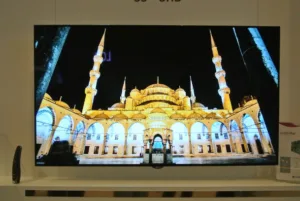A combination of company announcements, seemingly reliable reporting and just plain rumors make it reasonable to believe that OLED television is finally getting its second wind.

The reliable reporting centers on LG Display increasing its panel production, with LG Electronics modestly decreasing some set prices. The rumors center on Samsung re-entering the OLED-TV business, but the rumors have some foundation. Let’s see if we can sort through some of this.
LG Display (LGD) CEO Han Sang-Beom has said his company plans to ship 600,000 TV-sized OLED panels in 2015, going up to 1.5 million in 2016. LGD estimates the global high-end TV market at 4 million sets, which means that if LGD actually makes and sells those 1.5 million panels next year, OLED-TV will be grabbing more than a third of the high-end market. Although the estimate sounds as if it is being influenced by an excess of enthusiasm, there is a solid foundation for at least a portion of that enthusiasm.
LGD has increased the capacity at its Gen 8 fab to 14,000 substrates per month, which translates to the 600,000 panels projected for 2015. To support the predicted 1.5 million sets in 2016, input capacity will grow to 34,000 substrates per month by the end of 2015.
An LG representative recently told CNet that LG can’t meet the demand for OLED TVs and “cannot build OLED TVs fast enough”.
LG seems focused on maintaining its own OLED-TVs as premium products, with the emphasis on 4K. A carryover flat, FHD 55″ model is selling for $1999, while the new curved, 4k 55″ will carry an MSRP of $5499. My personal favorite of the OLED-TV screens LGD showed in its suite at CES was a lovely flat 4k 55″ (pictured above). No set price was given, but $3500 to $4000 would be a good guess.
The stories concerning Samsung are more speculative. What is not speculative is that Samsung is separating its LCD and OLED business (which it merged in 2012). The move is being seen as possibly being a positive for large-screen OLED at Samsung, since the OLED team will now be able to manage its own affairs without keeping an eye on what is good for the much larger LCD segment. (Samsung’s OLED group could not have been happy to see the Samsung exhibit at CES extolling quantum-dot-enchanced LCD-TV as superior to OLED-TV.)
Shortly before this announcement, rumors errupted that Samsung was planning to resume OLED-TV manufacturing. The rumors went on to predict that when Samsung does re-enter the market, it would like to do so using a version of the Kodak-LG color-by-white technology rather than its own RGB technology that has been so successful in small and medium displays.
This is a great rumor but the company is not confirming it, and there is an obvious difficulty: LG’s purchase of the Kodak IP and its own subsequent patenting activity make it difficult for Samsung to use this approach.
On the other hand, as revealed at the Nomura Pan-Asia Technology Conference in Hong Kong in May of 2011, Samsung was planning for its first Gen 8 OLED fab to use its RGB OLED technology, but for subsequent Gen 8 fabs to use color-by-white. And there have been other indications that senior Samsung display execs believe that color-by-white with oxide backplanes represent the future of large-screen OLED.
So, that Samsung is thinking of color-by-white for its return to OLED-TV manufacturing should not be a surprise – if they are returning at all. – Ken Werner

